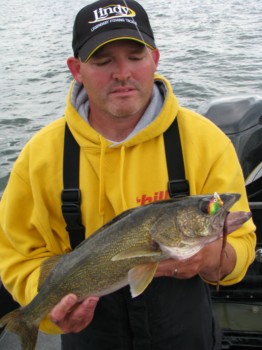Spinning Weeds
Category: article
Jul 19th, 2011 by OutdoorsFIRST
Modified Jul 19th, 2011 at 12:00 AM
Lindy pro staff angler Charlie Nelson of Duluth, Minnesota, isn’t afraid to invade aquatic jungles in search of walleyes. When walleyes forage for perch, shiners and other baitfish in submerged weeds, Nelson digs them out with Lindy Spinner Rigs.
 |
|
Nelson often plucks walleyes from cabbage weeds in the St. Louis River, which flows into Lake Superior. He employs several techniques that will work elsewhere for fishermen that are willing to tackle the greenery.
“A lot of guys won’t fish in the weeds because you’ve got to constantly pick the stuff off your spinners,” Nelson says. “It’s a pain, but that’s where the walleyes are.”
New Lindy Spinners
The New Lindy Spinners with willow leaf blades are Nelson’s go-to rigs when he fishes weeds. He favors the smaller No. 4 size blade because it mimics the perch and shiner minnows walleyes eat in the St. Louis River.
However, there are times when walleyes prefer a hard-thumping Colorado blade. When that happens, Nelson ties on a New Lindy Spinner with a small No. 3 Colorado blade. Little blades spin at slower speeds, Nelson claims. He typically pulls his spinners at 1.3 to 1.5 mph.
As for blade colors, Nelson does well with the lifelike Perch, Natural Perch and Shiner patterns. They perfectly match the baitfish walleye feed on in the St. Louis River. Lindy also offers patterns that match a wide variety of forage fish, including Alewife, Shad, Fathead, Golden Shiner, Purple Smelt, Rainbow Smelt and more.
Nelson dresses his spinners with crawlers 75 percent of the time and with leeches the other 25 percent. Leeches usually come into play during midsummer when the water warms and walleyes relate to weed edges near deep water.
Boards and Flatlines
When Nelson fishes spinners in weeds with two other anglers, he usually runs four planer boards off the sides of the boat and two flatlines off the transom. The inside boards are typically 15 feet from the boat. The outside boards are 30 feet out. By keeping the boards close, they can be pulled in quickly when the spinner snags a weed, which is a frequent nuisance.
“My boards are rigged with Tattle Flags,” Nelson says. “The flags tell me when a spinner has snagged a weed.”
Shimano 8 1/2-foot medium action trolling rods, Shimano line counter reels and 20-pound monofilament handle Nelson’s spinner-pulling duties. He prefers monofilament because the trolling board’s release holds it better than it does a thin diameter superline, such as FireLine.
Depth Control
The weeds in the tannic-colored water of the St. Louis River grow to a depth of 5 to 6 feet. How much, if any, weight Nelson adds to his spinner rigs depends on how high the weeds stand above the bottom.
 |
|
When the weeds are no more than 2 feet tall, Nelson pulls his Lindy spinners behind 3-ounce bottom bouncers. Since the vegetation isn’t thick at this stage, the bottom bouncer clears a path through the weeds for the spinner.
As the weeds grow taller, they become too thick to be brushed aside by the bottom bouncer. Nelson counters by attaching one or two No. 7 split shot to the line in front of the spinner rig. This gets the spinner deep enough to clip the top of the weeds.
When the weeds grow to within 2 feet of the surface, Nelson forgoes the split shot and pulls his Lindy spinners with no additional weight. Nelson lets out 30 feet of line behind the boards and the flatline rods when using weight. He lengthens that to 40 feet when he pulls spinners without weight.
Outside In
“I start out pulling spinners along the outside edges of the weeds in the morning,” Nelson says.
During the low, early morning light, walleyes typically feed along weed edges. The edge bite can hold up throughout the day under overcast conditions, especially when a breeze blows into the weeds.
The walleyes move deeper into the weeds when the sun gets up, and Nelson goes right in after them. It’s a chore to keep picking weeds off the spinners, but the work pays off with walleyes that run from 18 to 27 inches.
“It’s a blast catching a big walleye in shallow water,” Nelson says. “They pull harder when they can’t go deep.”
Casting Spinners
The last hurrah for catching walleyes from within the weeds, and not on the weed edge, happens when the vegetation grows within inches of the surface. Trolling is no longer effective then, so Nelson casts Lindy Spinner Rigs into the weeds without any weight.
For the casting presentation, Nelson switches to a 7-foot St. Croix medium-action spinning rod and a Shimano reel filled with 10-pound test FireLine, which has the diameter of 4-pound monofilament.
“You do your best to snake the spinner through the weeds,” Nelson says. “If you can keep the spinner clean for three quarters of the retrieve, you’ll catch some walleye.”
Weed Walls
Eventually, the weeds grow to the surface and become too thick to penetrate with spinner rigs. Because this happens during the heat of the summer, the walleyes relate to weed edges near deep water. They feed along the weed wall in the morning and drop into deeper water for the remainder of the day.
The weed edge is visible at this time, and it forms a vertical wall along the edge of the drop-off. Nelson trolls along this edge while keeping one of his outside boards as tight as possible to the weeds. He typically catches the walleye 4 to 6 feet deep along the weed edge in the morning.
“Two No. 7 split shot is enough to get my spinners down to the walleye with 50 feet of line out,” Nelson says.
When the sun pushes the walleyes deep, Nelson puts his spinners away. He continues to catch them by trolling Lindy Shadling crankbaits in deeper water.